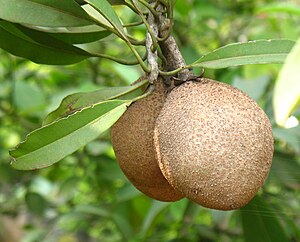Note: This is a project under development. The articles on this wiki are just being initiated and broadly incomplete. You can Help creating new pages.
Difference between revisions of "Manilkara zapota - Chikoo"
(→Photo Gallery) |
|||
| Line 1: | Line 1: | ||
[[File:സപ്പോട്ട.jpg|thumb|right|'''Chikoo''']] | [[File:സപ്പോട്ട.jpg|thumb|right|'''Chikoo''']] | ||
| − | '''Manilkara zapota''' commonly known as the sapodilla is a long-lived, evergreen tree native to southern Mexico, Central America and the Caribbean. | + | '''Manilkara zapota''' commonly known as the sapodilla is a long-lived, evergreen tree native to southern Mexico, Central America and the Caribbean. Sapodilla can grow to more than 30 m (98 ft) tall with an average trunk diameter of 1.5 m (4.9 ft). The average height of cultivated specimens, however, is usually between 9 and 15 m (30 and 49 ft) with a trunk diameter not exceeding 50 cm (20 in). It is wind-resistant and the bark is rich in a white, gummy latex called chicle. The ornamental leaves are medium green and glossy. |
==Uses== | ==Uses== | ||
Revision as of 10:07, 30 May 2020
Manilkara zapota commonly known as the sapodilla is a long-lived, evergreen tree native to southern Mexico, Central America and the Caribbean. Sapodilla can grow to more than 30 m (98 ft) tall with an average trunk diameter of 1.5 m (4.9 ft). The average height of cultivated specimens, however, is usually between 9 and 15 m (30 and 49 ft) with a trunk diameter not exceeding 50 cm (20 in). It is wind-resistant and the bark is rich in a white, gummy latex called chicle. The ornamental leaves are medium green and glossy.
Contents
- 1 Uses
- 2 Parts Used
- 3 Chemical Composition
- 4 Common names
- 5 Properties
- 6 Habit
- 7 Identification
- 8 List of Ayurvedic medicine in which the herb is used
- 9 Where to get the saplings
- 10 Mode of Propagation
- 11 How to plant/cultivate
- 12 Commonly seen growing in areas
- 13 Photo Gallery
- 14 References
- 15 External Links
Uses
Fever, Haemorrhage, Wounds, Ulcers, Diarrhoea, Indigestion, Urinary stones, Gall bladder stones, Thrush in babies.
Parts Used
Chemical Composition
sugars, proteins, ascorbic acid, phenols, carotenoids and minerals such as Fe, Cu, Zn, Ca and K[1]
Common names
| Language | Common name |
|---|---|
| Kannada | Chikku |
| Hindi | Chikoo |
| Malayalam | |
| Tamil | Chappotta |
| Telugu | Sima ippacettu |
| Marathi | NA |
| Gujarathi | NA |
| Punjabi | NA |
| Kashmiri | NA |
| Sanskrit | |
| English | Chikoo, Sapodilla plum |
Properties
Reference: Dravya - Substance, Rasa - Taste, Guna - Qualities, Veerya - Potency, Vipaka - Post-digesion effect, Karma - Pharmacological activity, Prabhava - Therepeutics.
Dravya
Rasa
Tikta (Bitter), Kashaya (Astringent)
Guna
Laghu (Light), Ruksha (Dry), Tikshna (Sharp)
Veerya
Ushna (Hot)
Vipaka
Katu (Pungent)
Karma
Kapha, Vata
Prabhava
Habit
Identification
Leaf
| Kind | Shape | Feature |
|---|---|---|
| Simple | Spiral | Foliar Shape(s) is Non-Palm Foliage (Elliptical), Foliar Apex / Tip is Acute and Foliar Base is Acute |
Flower
| Type | Size | Color and composition | Stamen | More information |
|---|---|---|---|---|
| Bisexual | Small | Green | Flowering Period is Free-Flowering and Flowering Opening Time is Time-Independent |
Fruit
| Type | Size | Mass | Appearance | Seeds | More information |
|---|---|---|---|---|---|
| Simple Fruit | Fruit Type is Fleshy Fruit (Non-Accessory Fruit: Berry) | Mature Fruit Colour is Brown | {{{6}}} |
Other features
List of Ayurvedic medicine in which the herb is used
Where to get the saplings
Mode of Propagation
Seeds, Cuttings, Air layering.
How to plant/cultivate
Sapodilla can grow well in a wide range of climatic conditions from the wet tropics to dry cool subtropical areas; but they prefer a moist hot climate similar to that found at medium to low elevations, usually below 600 metres. Trees are long-lived and slow-growing. The seeds of M. zapota germinate about 30 days after sowing without any treatment and exhibit an epigeal type of germination; they can, however, remain viable for several years if kept dry. [3]
Commonly seen growing in areas
Lowland forest, Coastal forests.
Photo Gallery
References
External Links
- Ayurvedic Herbs known to be helpful to treat Fever
- Ayurvedic Herbs known to be helpful to treat Haemorrhage
- Ayurvedic Herbs known to be helpful to treat Wounds
- Ayurvedic Herbs known to be helpful to treat Ulcers
- Ayurvedic Herbs known to be helpful to treat Diarrhoea
- Ayurvedic Herbs known to be helpful to treat Indigestion
- Ayurvedic Herbs known to be helpful to treat Urinary stones
- Ayurvedic Herbs known to be helpful to treat Gall bladder stones
- Ayurvedic Herbs known to be helpful to treat Thrush in babies
- Herbs with Fruits used in medicine
- Herbs with Stem used in medicine
- Herbs with Roots used in medicine
- Herbs with Shoots used in medicine
- Herbs with common name in Kannada
- Herbs with common name in Hindi
- Herbs with common name in Tamil
- Herbs with common name in Telugu
- Herbs with common name in English
- Habit - Tree
- Index of Plants which can be propagated by Seeds
- Index of Plants which can be propagated by Cuttings
- Index of Plants which can be propagated by Air layering
- Herbs that are commonly seen in the region of Lowland forest
- Herbs that are commonly seen in the region of Coastal forests
- Herbs
- Sapotaceae







